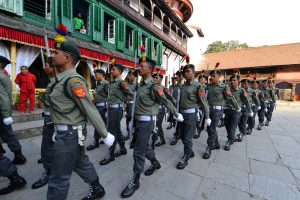Almost one month after the Russian invasion of Ukraine, reports emerged that a Nepali youth named Pratap Basnet was fighting for Ukraine. His story was widely noticed in Nepal. Nepal’s stated foreign policy is neutrality and non-alignment. However, on the Ukraine issue, Nepal’s government sided with the United States and the Western world to criticize Russia’s military attack on Ukraine’s territory.
Recently, evidence has emerged of Nepali youths joining Russian forces. On May 16, Russian authorities made it easy to access Russian citizenship after one year of military service in Russia. Since then, hundreds of Nepali youths have joined Russian forces as contract soldiers. Some of them are retired from the Nepal Army.
One Nepal Army retiree said he was working as a security guard in Dubai when he was lured to Russia by the more attractive offers. He traveled to Moscow as a tourist and joined the army at a Russian recruitment center. He noted that lowered standards made it possible for him to enlist. “Previously they would look for Russian language proficiency. Now English is also okay for it,” the retiree told me over Telegram. (He later blocked me after deciding against further contact with a journalist).
He is now in a military training camp in Russia. “Training is not hard for me as I have gone through similar training in Nepal Army also,” he said. “But weapons here are more modern than what I would get in Nepal Army training.”
There is no publicly available data on the number of Nepali youths joining Russian forces. But it is an open secret that Nepali youths are enlisting as private citizens.
Nepal has a long tradition of sending its youths to serve as soldiers for the British and Indians through formal channels. Nepali youths have been drafted into the British Army since 1815 as “British Gurkhas.” This tradition carried over after India achieved independence through the “Indian Gurkhas.” Nepal’s Gurkha Contingent has also been actively engaged in the Singapore Police since 1949, again through the British connection.
However, Nepal does not have any other bilateral agreements to send its youths to serve in foreign militaries. Yes, Nepal is the second largest troops-contributing country for the United Nations Peacekeeping Forces all around the world. But Nepal does not send its military to non-U.N. missions.
Nepal’s former Chief of Army Staff Purna Chandra Thapa, in an interview with me, had rejected the idea of Nepal sending its military for non-U.N. missions which he said was contrary to Nepal’s official foreign policy.
Despite Nepal’s neutral foreign policy priority, Nepali youths are not just working in foreign militaries through formal channels but are also joining foreign forces as private citizens. For example, it is estimated that thousands of Nepali youths have joined the Foreign Legion of the French Army, even though there is no official agreement between Nepal and France toward this end.
In the United States also, Nepal ranks as one of the top sources of immigrants willing to join the U.S. Army as a path to get U.S. citizenship. Based on the data of the United States Citizenship and Immigration Services (USCIS), Nepal ranked seventh in this regard, behind the Philippines, Mexico, China, South Korea, Jamaica, and Nigeria.
These instances illustrate that there is nothing unique about the Russia-Ukraine war that is drawing Nepali youth to join. Rather, Nepal’s young men have long shown a willingness to enlist in foreign forces. There are three main reasons for this dynamic.
First, Nepal has a long history of fierce fighting and pride in martial prowess is part of the national psyche. Modern Nepal was formed after military conquests of dozens of principalities. Besides domestic fighting experience, Nepalis fought with the collective forces of Tibet and China in 1791. On behalf of the British, Nepali youths have fought in almost all of Britain’s wars since 1815. The same is true for India since its independence. Whether officially or privately, Nepal has a long tradition of sending soldiers to fight for foreign armies, making it an easily thought-of option for today’s youth.
And those youth are in desperate need of options. Young Nepalis cannot find enough resources and opportunities in Nepal. Unemployment, low pay, and lack of vacancies in Nepal’s own military are other factors driving Nepali youths out of Nepal to enlist with foreign forces.
It seems like Nepali youths are eager to join all active militaries – irrespective of ideological lines – if they can secure respect and good payment. That is why we see Nepali youths fighting alongside both Ukrainian and Russian forces.

































